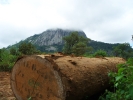- Details
 After a long conflict with local communities and conservationists, it looks like the sun is setting on the proposed Est-For pulp mill in Estonia. The Estonian government has announced its decision to “initiate the termination” of the national designated spatial plan for the mill. The project was strongly opposed by Estonian NGOs, by local communities and by the people. The municipality of Tartu, the city where the pulp mill was planned, had started a court case against the government.
After a long conflict with local communities and conservationists, it looks like the sun is setting on the proposed Est-For pulp mill in Estonia. The Estonian government has announced its decision to “initiate the termination” of the national designated spatial plan for the mill. The project was strongly opposed by Estonian NGOs, by local communities and by the people. The municipality of Tartu, the city where the pulp mill was planned, had started a court case against the government.
- Details
 Environmental Paper Network released the Environmental Paper Network released the The State of the Global Paper Industry, a civil society review of the social and environmental performance of the paper industry. The 2018 report’s assessment is structured according to the goals of the EPN’s Global Paper Vision informing on trends in consumption, recycled content, social responsibility, responsible virgin fibre sourcing, greenhouse gas emissions, clean production and transparency.
Environmental Paper Network released the Environmental Paper Network released the The State of the Global Paper Industry, a civil society review of the social and environmental performance of the paper industry. The 2018 report’s assessment is structured according to the goals of the EPN’s Global Paper Vision informing on trends in consumption, recycled content, social responsibility, responsible virgin fibre sourcing, greenhouse gas emissions, clean production and transparency. - Details
 How do you find your way out of a forest in Iceland? Stand up. - That's an old Icelandic joke about the country's meager woodlands, and like most jokes, it contains a kernel of truth. Iceland is a famously beautiful place, yet forests only cover about 2 percent of its land area, and they tend to be relatively small. This hasn't always been the case, however. According to one early saga, "At that time, Iceland was covered with woods, between the mountains and the shore." When the first Vikings arrived in Iceland, they began chopping down and burning Iceland's forests for timber, and to clear space for farmland and grazing pastures. "They removed the pillar out of the ecosystem," Gudmundur Halldorsson, research coordinator for the Soil Conservation Service of Iceland, recently told the New York Times Gudmundur Halldorsson, researcher at the Soil Conservation Service island.
How do you find your way out of a forest in Iceland? Stand up. - That's an old Icelandic joke about the country's meager woodlands, and like most jokes, it contains a kernel of truth. Iceland is a famously beautiful place, yet forests only cover about 2 percent of its land area, and they tend to be relatively small. This hasn't always been the case, however. According to one early saga, "At that time, Iceland was covered with woods, between the mountains and the shore." When the first Vikings arrived in Iceland, they began chopping down and burning Iceland's forests for timber, and to clear space for farmland and grazing pastures. "They removed the pillar out of the ecosystem," Gudmundur Halldorsson, research coordinator for the Soil Conservation Service of Iceland, recently told the New York Times Gudmundur Halldorsson, researcher at the Soil Conservation Service island.
- Details
 At the recent CITES meeting held in Johannesburg, a decision was passed to list the entire Dalbergia genus in Appendix II of the CITES convention meaning only controlled trade in sustainable volumes will be allowed. By consensus CITES has placed the entire Dalbergia genus of rosewood under trade restrictions. CITES (the Convention on International Trade in Endangered Species of Wild Fauna and Flora, also called the Washington Convention) is an international agreement to ensure that international trade of wild animals and plants does not threaten the survival of their species. Demand, especially in Asia, has had a devastating impact on available resources in South‐East Asia and traffickers are now tapping alternative sources in Africa and Central America.
At the recent CITES meeting held in Johannesburg, a decision was passed to list the entire Dalbergia genus in Appendix II of the CITES convention meaning only controlled trade in sustainable volumes will be allowed. By consensus CITES has placed the entire Dalbergia genus of rosewood under trade restrictions. CITES (the Convention on International Trade in Endangered Species of Wild Fauna and Flora, also called the Washington Convention) is an international agreement to ensure that international trade of wild animals and plants does not threaten the survival of their species. Demand, especially in Asia, has had a devastating impact on available resources in South‐East Asia and traffickers are now tapping alternative sources in Africa and Central America.
- Details
 The multibillion-dollar effort to plant a 5,000-kilometer-long wall of trees failed. A Great Green Wall of trees 10 kilometers wide and 5,000 kilometers long, bisecting a dozen countries from Senegal in the west to Djibouti in the east. Planting trees across the Sahel, the arid savanna on the south border of the Sahara Desert, had no chance to succeed. There was little funding. There was no science suggesting it would work. Moreover, the desert was not actually moving south; instead, overuse was denuding the land. Large chunks of the proposed "wall" were uninhabited, meaning no one would be there to care for the saplings.
The multibillion-dollar effort to plant a 5,000-kilometer-long wall of trees failed. A Great Green Wall of trees 10 kilometers wide and 5,000 kilometers long, bisecting a dozen countries from Senegal in the west to Djibouti in the east. Planting trees across the Sahel, the arid savanna on the south border of the Sahara Desert, had no chance to succeed. There was little funding. There was no science suggesting it would work. Moreover, the desert was not actually moving south; instead, overuse was denuding the land. Large chunks of the proposed "wall" were uninhabited, meaning no one would be there to care for the saplings.



